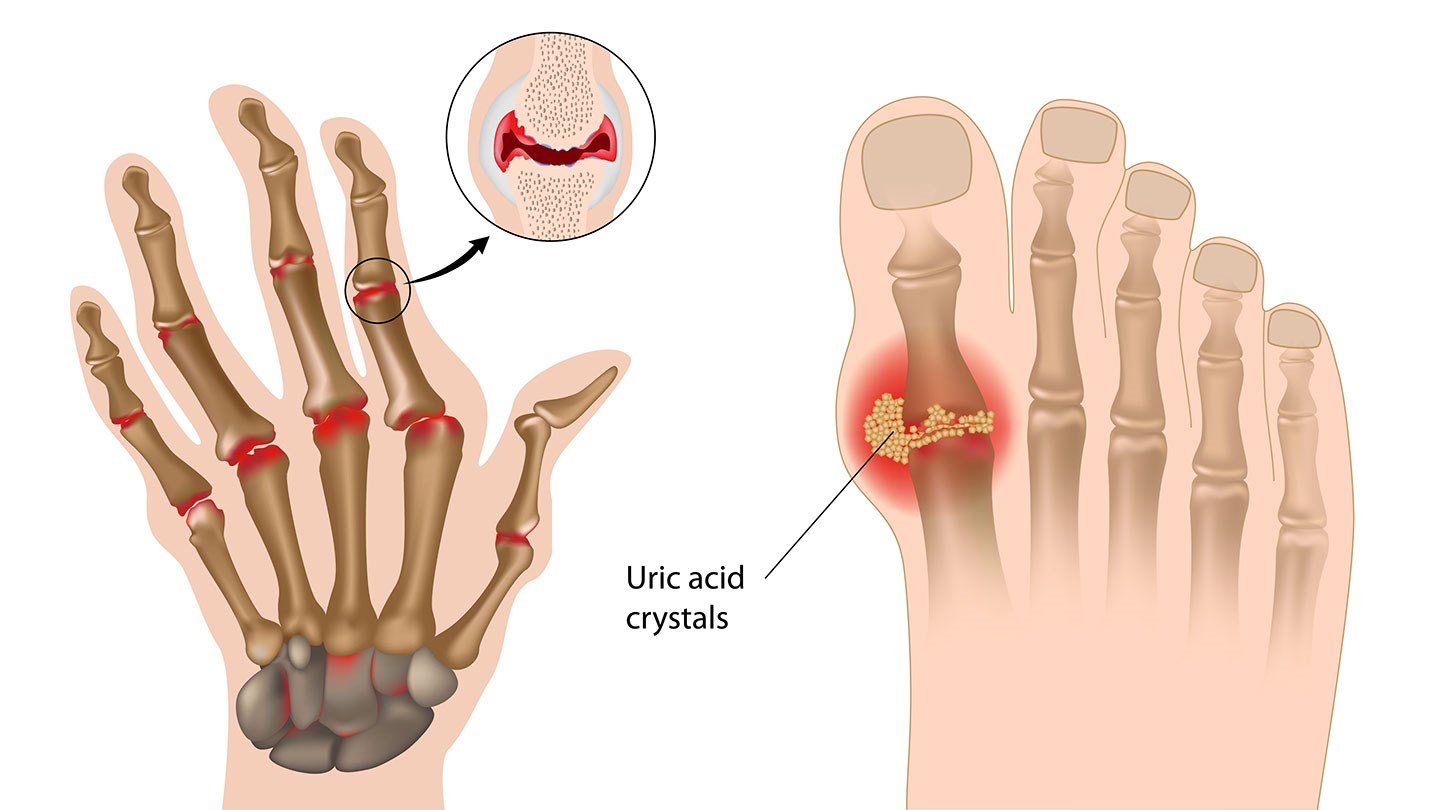
By Theodore Fields, MD, CreakyJoints Adviser
Arthritis awareness advocates have been busy! May is Arthritis Awareness Month, and today, May 22, is Gout Awareness Day. Like rheumatoid arthritis (RA), gout is known for symptoms such as joint pain, swelling, and stiffness. You may have heard of gout and its symptoms, but do you understand the true impact of this rheumatic disease?
Rheumatoid Arthritis vs. Gout
We don’t know the exact cause of rheumatoid arthritis, but we know that changes in some of the body’s proteins can set off activation of the immune system, which leads to the release of multiple inflammatory chemicals (cytokines) that cause joint inflammation and damage, with swelling, warmth, tenderness, and discomfort.
Gout Causes and Symptoms
On the other hand, gout is an inflammatory type of arthritis that is caused when there is too much uric acid in the body. Uric acid, a normal waste product formed during the breakdown of certain foods, is usually eliminated by the body as urine. But if too much uric acid builds up or cannot be filtered by the kidneys, acid crystals form in the joints. Our immune system sees the crystals as “foreign bodies” and attacks them as it would a splinter, causing local inflammation, redness, heat, and a lot of pain.
CreakyJoints recently conducted a comprehensive survey of people with gout and their caregivers that revealed how much of an impact this condition has on people living with it, as well as on their loved ones.
For example:
- Employed gout patients surveyed reported missing an average of 6.3 days of work in the last year because of painful gout attacks.
- Caregivers who are employed missed almost five days because they had to provide care or assistance to a loved one experiencing a painful gout attack.
- Nearly 70 percent of patients surveyed said gout has a negative impact on their family; 74 percent of caregivers agree.
These shocking findings make it clear that gout not only impacts patients, but it also takes a toll on caregivers.
How to Distinguish Gout From RA
It can be confusing to tell the difference between RA and gout, so here is some helpful background information to help distinguish between the two:
1. Which joints are involved?
Gout is most common in the big toe, at the joint where the toe meets the foot. Gout is also common at the ankles, midfoot, knees, and elbows. It is usually in later stages of gout when small joints in the hands are involved. RA, however, tends to involve the smaller joints in the hands early on. The pattern of joint involvement is very helpful to physicians in differentiating between gout and RA.
2. What does a gout attack feel like?
If someone thinks they are getting a gout attack, they should look out for the joint's turning red, which is more common in gout than in RA. While RA is painful, a gout attack is often so intense that the sufferer has great difficulty walking. People with RA can have difficulty walking as well, but the sudden intensity and immediate loss of function is usually more dramatic in gout. The onset of RA pain is more gradual, while the pain from gout generally reaches its peak within 24 hours.
The duration of gout flares is typically limited even without treatment — lasting two weeks or less — but RA flares usually last longer unless treated. Most gout patients are in so much pain, however, that they need to be treated and can’t wait for the flare to quiet down by itself. In fact, the pain from a gout flare can be so excruciating that, in the CreakyJoints survey, 44 percent of female gout patients with children agreed with the statement that gout attacks are “more painful than childbirth.”
3. What is a “uric acid level,” and why is it important?
If you’re experiencing joint pain that seems like possible gout, it would be helpful to get your blood uric acid level tested by your physician. If your uric acid levels are high and your symptoms are similar to those described above, gout is very likely. If the diagnosis of gout is not clear, fluid can be removed from a swollen joint and the uric acid crystals can be seen under a microscope. Once crystals are seen, the diagnosis of gout is made.
Yet often, the symptoms, exam, and uric acid levels make the diagnosis of gout extremely clear, and examination of the fluid for crystals is not needed. The American College of Rheumatology recommends that patients with gout achieve a target blood uric acid level below 6 milligrams per deciliter (mg/dL). Keeping the level below 6 over time leads to complete resolution of gout flares for the vast majority of people.
Luckily, gout is an extremely treatable condition, so getting a proper diagnosis and appropriate management is critical. For more information, please visit CreakyJoints.org/goutsurvey.
Theodore Fields, MD, is an adviser to CreakyJoints and the clinical director of the Inflammatory Arthritis Center's Early Arthritis Initiative at the Hospital for Special Surgery in New York City. CreakyJoints is an online community of patients and families looking for arthritis resources and support. Founded in 1999, it now includes more than 100,000 arthritis patients and their families. To learn more and to join for free, go to CreakyJoints.org.
Photo Credit: Shutterstock (2)
On – 22 May, 2017 By
